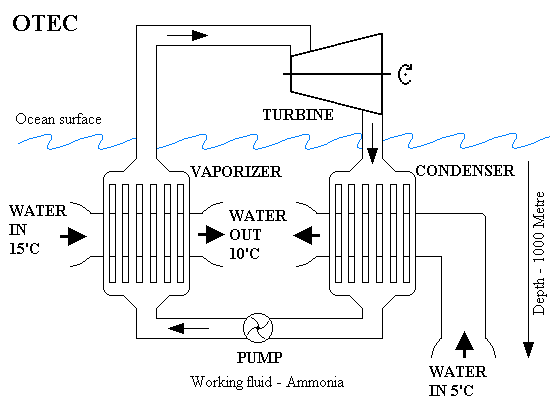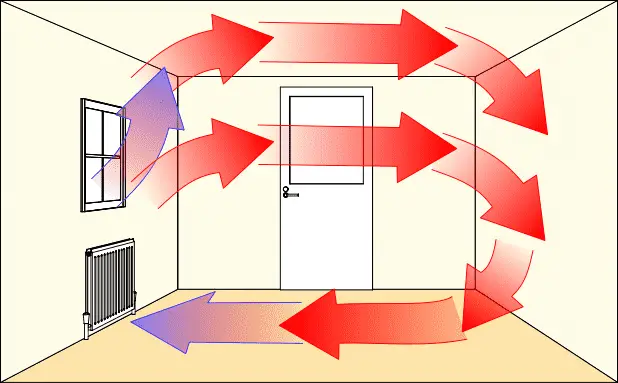OTEC Definition and Working Principle Explained
OTEC is the sum total of processes, techniques and technologies used to capture, convert and generate power from solar thermal energy that is stored in the ocean. This article discusses OTEC definition and working principle, as outlined below;
-OTEC Definition: 5 Ways to Define Ocean Thermal Energy Conversion
-How OTEC Works: Ocean Thermal Energy Conversion Principle and Steps
OTEC Definition: 5 Ways to Define Ocean Thermal Energy Conversion
OTEC is an abbreviation for Ocean Thermal Energy Conversion; which is the act and process whereby thermal energy in the ocean is converted to other forms such as mechanical energy and electricity, which are more usable to meet human energy needs [2].
Ocean thermal energy is stored energy in the ocean, which can be observed in the form of significant temperature differences between various zones, depths or layers of the ocean.
It is important to note that the primary source of ocean thermal energy is the Sun, which means that ocean thermal energy is a hydrologically-stored form of solar energy.
The following OTEC definition acknowledges this link, while describing ocean thermal energy conversion as a renewable energy mechanism;
OTEC is a mechanism by which renewable solar energy in the ocean or sea is extracted, using systems that capture and transform this energy into more-usable forms.
The basic attributes of ocean thermal energy make it similar to other hydrological and thermal forms of energy like hydro, wave, tidal and geothermal energies, in terms of the mechanisms by which it is stored, transferred and released.
There are also similarities between ocean thermal and these other forms of energy, in terms of application. Below is an alternative OTEC definition that lists some uses of the conversion process;
OTEC is the process of utilizing the spatial temperature gradient in marine ecosystems to drive turbines and produce mechanical energy and generate electricity.
In several cases, OTEC systems work based on the principle of the Rankine Cycle, which is the same which governs most steam turbines [3].
The OTEC definition below describes the concept from a principle perspective, in an attempt to highlight how OTEC works;
OTEC is a renewable energy mechanism and technology that works by capturing thermal energy from surface marine water, then using this energy to vaporize a low-boiling point working fluid like ammonia (28-32 °C) so that the pressure from the resulting vapor is used to spin a turbine and generate electricity [5].
Lastly, OTEC definition is outlined on the basis of energy transfer and transformation;
OTEC is a mechanism whereby solar thermal energy that is stored in the ocean is transferred to a working fluid and converted to mechanical energy using a turbine, which may be used for electricity generation.
The above definition implies that the ocean is an energy storage system or reservoir, which retains heat from solar radiation. Also, all versions of the OTEC definition here have highlighted links with other concepts like renewable energy development, energy transformation, sustainable development, energy conversion, electromagnetism and electric generator technology.
OTEC is an important concept with regards to the energy transition from fossil fuels to cleaner energy resources, because ocean thermal energy has no significant emissions associated with it.
How OTEC Works: Ocean Thermal Energy Conversion Principle and Steps
OTEC works in three (3) simple steps, which are; thermal energy capture, thermo-mechanical conversion, and electricity generation.
These steps are based on the Rankine Cycle; a thermodynamic model of energy transfer that utilizes simple conversion mechanisms to generate electricity from thermally-energized fluids [6]. They are each discussed below;
1). Thermal Energy Capture (in explanation of How OTEC Works)
An OTEC system captures thermal energy from shallow, surface water in the ocean, which is generally warm with temperatures that range between 20-50 °C.
The thermal energy itself comes from continuous solar heating, which establishes an inverse hydrothermal gradient in oceans where temperature temperature tends to decrease with increase in depth.
Components of an OTEC power plant or system are; working fluid, heat exchanger/evaporator, pumps, turbine, electric generator, and flow-pipes [1] [3].
The parts that are primarily involved in thermal energy capture are; working fluid, heat exchange or evaporator, and pumps.
During thermal energy capture, warm surface water from the ocean is pumped into the heat system so that it is in direct contact with the heat exchanger. The working fluid in the heat exchanger, captures heat from the seawater through the thermal energy-transfer mechanism of conduction.
Due to its low boiling point, the working fluid (which is often ammonia) is transformed to vapor phase, with increase in both temperature and pressure.
It must be noted that OTEC systems can be distinguished into two types based on the mechanism of working fluid-circulation; which are closed cycle and open cycle OTEC systems.
OTEC open cycle system does not depend on a low-boiling point working fluid like ammonia to spin the turbine. Rather, it vaporizes warm seawater directly, by collecting this water in a low-pressure chamber (also called vacuum chamber) which causes it to convert to vapor phase at warm temperature [2].
OTEC closed cycle system is the type of ocean thermal energy system that is solely dependent on low-boiling point fluid to generate vapor from warm seawater, and spin the turbine. It is called 'closed' because the working fluid is enclosed securely in a heat exchanger that allows it to be recycled continuously by vaporization and condensation; through heat exchange with warm and cold seawater, respectively.
While the closed OTEC cycle system is often energy efficient, it is less sustainable for the ecosystem; due to the risk of ocean pollution that is associated possible leakage of working fluid from the heat exchanger and fluid-flow units.
2). Thermo-Mechanical Conversion
Thermo-mechanical conversion one of the two conversion processes that are involved in ocean thermal energy conversion as a whole. It is simply the process whereby thermal energy from seawater is converted to mechanical energy.
The main component of an ITEC plant that is involved in thermo-mechanical conversion is the turbine; which is made to rotate at significant speed by the impulsive force and velocity of vapor from the OTEC evaporator [4].
Turbines in OTEC systems are similar in design and working principle to conventional steam and gas turbines. They are equipped with movable rotor blades that come in contact with expanding gaseous working fluid from evaporator, which exerts pressure on the blades and causes them to spin, along with the shaft and the rest of the turbine.
3). Electricity Generation (in explanation of How OTEC Works)
Electricity generation is the final step in the working principle of an OTEC system.
The principle behind electricity generation itself, in OTEC systems, is the principle of electromagnetic induction. This describes the flow of charges through a rotating conductor in a magnetic field; where rotation comes from the turbine.
The amount of energy that OTEC can produce is over 80,000 TWh per annum, based on estimates of energy storage rate and capacity of the ocean. Oceans have thermal energy capacity of up to 0.8 Watts per square meter, on average, and this value varies with geographic location, so that regions close to the equator record the highest amount of stored thermal energy.

Conclusion
Ocean thermal energy conversion (OTEC) is the process and technology that extracts heat from the warm surface water of oceans, and uses this heat to generate vapor that drives a turbine to produce electricity.
OTEC works based on a three-step principle that includes;
1. Thermal Energy Capture
2. Thermo-Mechanical Conversion
3. Electricity Generation
References
1). Adiputra, R.; Utsunomiya, T.; Koto, J.; Yasunaga, T.; Ikegami, Y. (2019). "Preliminary design of a 100 MW-net ocean thermal energy conversion (OTEC) power plant study case: Mentawai island, Indonesia." Journal of Marine Science and Technology 25(1). Available at: https://doi.org/10.1007/s00773-019-00630-7. (Accessed 12 March 2023).
2). Cuartas, J. A. H.; Acuña, S. S.; Ibeas, A. (2021). "Ocean Thermal Energy Conversion and Other Uses of Deep Sea Water: A Review." Journal of Marine Science and Engineering 9(4). Available at: https://doi.org/10.3390/jmse9040356. (Accessed 12 March 2023).
3). Ikegami, Y.; Yasunaga, T.; Morisaki, T. (2018). "Ocean Thermal Energy Conversion Using Double-Stage Rankine Cycle." Journal of Marine Science and Engineering 6(1). Available at: https://doi.org/10.3390/jmse6010021. (Accessed 12 March 2023).
4). Liu, W.; Ge, Y.; Liu, L.; Chen, Y. (2020). "Current Development and Prospect of Turbine in OTEC." Ocean Thermal Energy Conversion (OTEC) - Past, Present, and Progress. Available at: https://doi.org/10.5772/intechopen.90608. (Accessed 12 March 2023).
5). Samsuri, N.; Sazali, N. F.; Jamaludin, A. S.; Razali, M. N. M. (2021). "Performance of Ocean Thermal Energy Conversion Closed Rankine Cycle Using Different Working Fluids." IOP Conference Series Materials Science and Engineering 1062(1):012040. Available at: https://doi.org/10.1088/1757-899X/1062/1/012040. (Accessed 12 March 2023).
6). Yang, M-H.; Yeh, R-H. (2014). "Analysis of optimization in an OTEC plant using organic Rankine cycle." Renewable Energy 68:25–34. Available at: https://doi.org/10.1016/j.renene.2014.01.029. (Accessed 12 March 2023).





